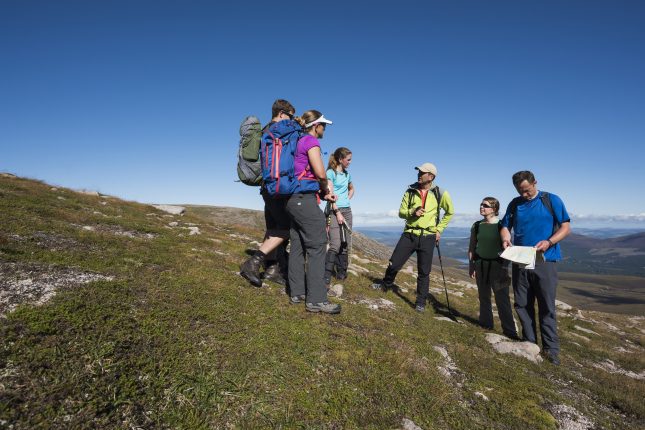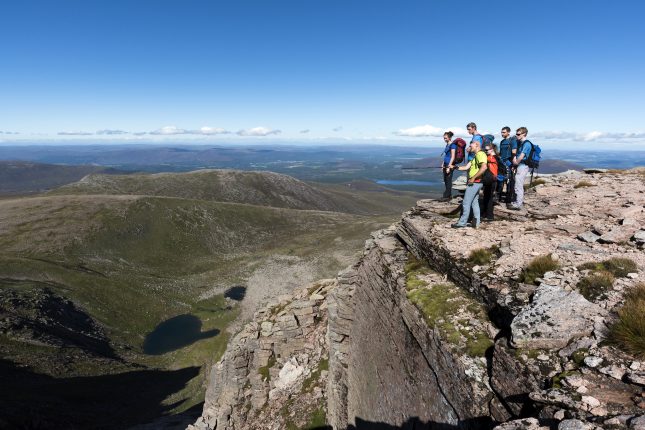Summer Mountain Leader Assessment Overview & Advice
Assessments are unavoidably a source of worry and anxiety for most of us. To help ease some nerves about the Summer Mountain Leader Assessment, in this blog Senior Instructor Bill Strachan talks through what it involves and answers some frequently asked questions. Hopefully by reducing the number of unknowns, you can have a better picture of what you’re going into and feel more able to perform your best when your assessment arrives this summer!
The pathway to becoming a Summer Mountain Leader (ML) is fairly straightforward on paper. You register as a candidate with Mountain Training, and book yourself onto a Summer ML Training course. Before you attend the course, you should have a fair bit of experience as a hillwalker, amounting to 20 Quality Mountain Days (QMDs). After attending the 6-day training course, you’ll come away with feedback that you can then put into practice over the duration of a consolidation period.
Summer Mountain Leader Assessment Pre-requisites
You can find all the details of the pre-requisites for the Summer ML Assessment on Mountain Training’s website in the Candidate Handbook. During the consolidation period, you should acquire 40 QMDs across three different mountain regions of the UK and Ireland for your DLOG. You should also record 8 nights of camping, of which at least 4 should be wild camping. When you’re away from the facilities and accessibility of a campsite, you have to work harder to leave the environment as you found it and plan your equipment more.
If you have only logged the minimum of 40 Quality Mountain Days prior to your assessment then it’s likely that you’re going to have a harder time than those who have more experience.
Rather than a black and white approach, assessors take a holistic view of your performance throughout the week. Your logbook is one element of this. If you’ve got a really strong logbook and have a wobble of some sort on the assessment, as most people do in these things (we’re only human!), then the assessor is more likely to put it down to nerves because you’ve provided evidence to show your experience.

What does the Summer Mountain Leader Assessment look like?
The assessment to become a Summer Mountain Leader is 5 days long. Though certain days focus on specific aspects of the syllabus, key themes will be present across the week. For example there will be elements of navigation, leadership, and environmental knowledge almost every day.
Day One
At the start of the week, the assessor will get to know the candidates and go through the key points of the syllabus. On the first day on the hill, the nav should be fairly straightforward. The assessor doesn’t want to make you unnecessarily nervous in case this results in a silly mistake or knocks your confidence. They want to see you relaxed in the environment and get a sense for how you interact with the group. As you progress on your journey, show a bit of leadership and provide some environmental input. Through the day you’ll discuss scenarios that can arise while leading a group on the hill and what you would do in those potential circumstances, so the assessor can see that you would know how to manage an incident.
There often aren’t black and white or correct and incorrect answers. For instance, when looking at what everyone has packed in their bags or going through the home paper. Rather than a hard pass or fail, the assessor wants to build an understanding of you, your decision-making processes, and your experience.
View group discussions as opportunities to continue learning from the other candidates and to share knowledge. We would like you to relax into the assessment. Have a mindset of expecting to come away from the week having learned more, as well as having demonstrated your ability against the standard of the award. If you don’t know about something, such as a plant or why another candidate has packed something you didn’t, why not ask them? That being said, while learning through the week is nice to have alongside the assessment process, you’re still expected to have a suitable degree of knowledge about the relevant subjects.
Day two
On day two, you’ll head for some steeper ground and use the walk in for a bit of navigation. The terrain is unlikely to be anything extremely technical or exposed. It is more likely to consist of a bit of scree, some bouldery ground and a bit more gradient. In this context, the assessor is looking for appropriate leadership, slick ropework, and confident movement on broken terrain.
You should be able to change your leadership style so it’s appropriate to the changing terrain. Adapt the way you lead people for the environment that you’re in. If the environment changes and becomes more consequential, you may need to take more ownership. Perhaps be more assertive and share tips to help your group, rather than taking a ‘just follow me’ approach. This doesn’t just apply to changing terrain. You should also be able to see how well you’re engaging your group and try a different approach if needed.
What do I need to know how to do when it comes to ropework?
The assessor is looking to see that you can select and use an appropriate anchor, tie your group member onto the rope and use the rope to safeguard them down a small, potentially consequential step. The assessor would like to see this done efficiently and confidently
You can practice some of this at home, you should aim to get out and practice in more uncomfortable environments. This will help you become used to operating with less wiggle room. This doesn’t need to be halfway up a mountain, just somewhere a bit rockier or with more boulders around. As the assessor will be looking at the big picture of your performance, appearing completely unprepared doesn’t make a good impression… And is unlikely to result in a pass! But if you’re generally doing things well and in a way that shows you’re practiced, though perhaps still with room for improvement, then they’ll offer some advice on how to fine tune your skills.
How much scrambling experience do I need?
You don’t have to be a grade 3 scrambler. You should be comfortable in broken and steeper terrain, so you can support group members who will be less comfortable in that environment.
Knowing how to adjust your route for the group, how to manage someone down steeper terrain without rope, and when to use a confidence rope if it’s necessary, are what the assessor is looking for.

Mountain Expedition
The following day you’ll set off on a two-night mountain expedition. You’ll just be carrying your personal hill kit for the 3 days. It’s unlikely that you’ll be asked to carry a rope. The navigation legs of your journey will be split between candidates. In nice weather you can chat away with the group and enjoy your surroundings. In poor visibility, you’ll need to adjust your techniques accordingly. The aim is for efficient navigation. Realistically, on a clear day you’re unlikely to need to follow a compass bearing. If the visibility is too clear through the days, then there might be some night navigation to simulate the poorer visibility that we often get in the mountains.
The total distance walked each day might be a bit more than on the ML Training. Though the navigation is unlikely to be particularly demanding, the expectation is that you will actively lead the group. When the final day comes around, it’s nice if it can be relatively relaxing and conversational. This is a good time for sharing some environmental knowledge and what everyone has hopefully learned from each other. The last morning is likely when you’re being seen at your most natural. Before a straightforward return leg back to the Lodge for lunch and to hear your result shortly afterwards.
Finding out your result & next steps
There are three possible outcomes at the end of your Summer Mountain Leader Assessment. The result everyone hopes for is obviously a pass, which is fantastic news! You may still receive feedback on how you can continue to improve your skills and knowledge. If there was only one area of the syllabus where you were unable to meet the standard needed on this occasion, you may receive a deferral. The assessor will explain what you can do to perform better. Rather than having to re-sit the assessment in its entirety, you can return after three months to be assessed on that area. If you don’t pass after re-attempting this three times, you do however have to re-do the whole 5 days.
Should you receive a ‘fail’ at the end of the assessment, you’ll be given detailed feedback on the areas of the syllabus where you didn’t meet the standard. To help you learn and improve on these areas, the assessor will share with you their understanding of why you didn’t meet the standard and advise you on possible next steps to improve. At the time of hearing a negative result, most of us understandably aren’t in the right headspace to process feedback. So you’ll be able to receive it in written form to take away with you. And of course, you’re always welcome to get in touch for further constructive support.
We hope this has been helpful, and wish you the best of luck on your assessment this summer!